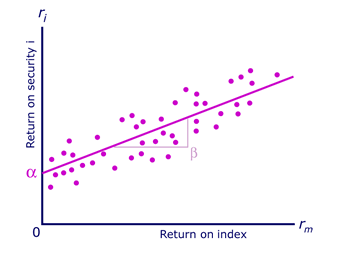Beta coefficient is a comparative measure of how the stock performs relative to the market as a whole. It is determined by plotting the stock’s and market’s returns at discrete intervals over a period of time and fitting (regressing) a line through the resulting data points. The slope of that line is the levered equity beta. When the slope of the line is 1.00, the returns of the stock are no more or less volatile than returns on the market. When the slope exceeds 1.00, the stock’s returns are more volatile than the market’s returns. The beta coefficient is a key component for the Capital Asset Pricing Model (CAPM), which describes the relationship between risk and expected return and that is used in the pricing of risky securities.
The important types of stock beta used in financial analysis are historical beta, adjusted beta and fundamental beta.
An historical betas are simply the slope of a regression line between returns on a stock and returns on some market index during some past period. Historical betas can vary significantly depending on the length of the holding period used (i.e., days, weeks, months, or years) and the number of time periods included (i.e., the number of years of data used). There is no “theoretically correct” procedure, and what’s “theoretically correct” probably varies from investor to investor and over time for a given investor. For example, one person might have a short time horizon and buy stocks thinking about returns over a few days or weeks, while another might buy for the “long haul” and not even check his or her results except annually, and the investor’s time horizons might change over time.
Adjusted betas are generally calculated as some sort of average between the historical beta (however calculated) and 1.0. The logic behind adjusted betas is that historical betas that are far removed from 1.0 probably reflect temporary events that will dissipate over time, hence betas will tend “to regress toward the mean of 1.0 over time.” Empirical tests support the idea of adjusting betas, but no one knows exactly how the adjustment should be made.
The concept of fundamental betas, to take account of the fact that fundamental conditions within companies change over time, and those changes might not be reflected in historical betas. For example, it is well recognized that the more financial leverage a company uses, the higher its beta should be. However, if the historical beta is calculated using say 5 years of monthly data, and if the company changes its capital structure toward the end of the 5 year period, then the historical beta may not reflect the risk for the company in the future, which is what we are really interested in. Other fundamental factors such as the type of assets the company is investing in, or conditions in its industry (such as the electric utilities as they make the transition from regulated monopolies to competitive companies) could also cause the future beta to differ from the historical beta.
